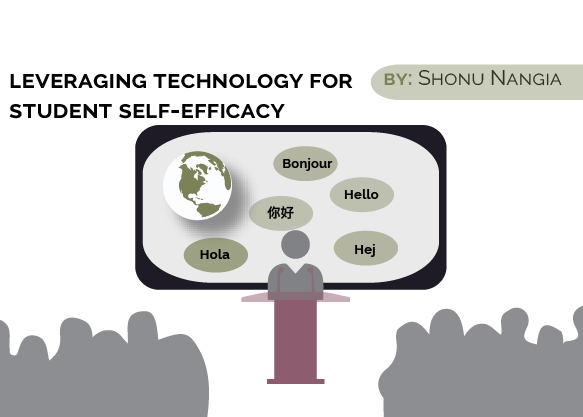Foreign Language Performance: Leveraging Technology for Student Self-Efficacy
 By Shonu Nangia, Associate Professor of Foreign Languages, Louisiana State University at Alexandria.
By Shonu Nangia, Associate Professor of Foreign Languages, Louisiana State University at Alexandria.
In this article, I discuss the adaptive use of technology and the design of differential learning experiences as a solution to anxiety related performance problems in the foreign language classroom. I share a student driven innovation – an alternative “public performance” – that made empowering use of technology and was designed to overcome incapacitating anxiety in the specific case of a very shy and introverted student. The success of the project confirms that individualized and customized technology assisted projects can be an effective instructional strategy in a language classroom which comprises a student body with varying needs and diverse learning styles and illustrates how technology can be employed in creating differentiated learning experiences that are effective in helping special needs students succeed without compromising the objectives, rigor, and quality of the course.
The approach described in this article involves a creative adaptation of an assessment tool routinely used in first year foreign language college courses – the Oral Exam. This project involved the use of an iPad camera and the video-sharing website YouTube to accommodate a student with special needs and allowed her to successfully fulfill a vital component of the foreign language course. The design of the project derives from the UDL or the Universal Design for Learning framework that emphasizes the development of flexible learning environments and approaches in order to provide learners alternate options for engagement (The Principle of Multiple Means of Engagement) and alternatives for demonstrating what they know (The Principle of Multiple Means of Action and Expression).
THE RATIONALE AND THE METHOD
In my first year French and Spanish courses (1001 and 1002), an important cumulative oral exam is normally programed towards the end of the semester. This final oral exam consists of 5-7 minute long skits that students, in groups of three or four, conceive, script, edit, (quasi -) memorize, practice, and finally enact in front of the entire class in order to demonstrate their progress in the spoken aspects of the target language. This is a cumulative exam, and students are asked to incorporate material from all the chapters that were covered in that semester. I find it to be an invaluable assessment in as much as it gets students to first apply their learning to design and produce an artifact (partly in class and partly outside of class) and subsequently demonstrate their learning publicly (in class) via the artifact (the production/performance).
Most of the time, these oral exam skits are viewed by students as fun-filled group projects and result in heightened student motivation because students feel excited at the prospect of putting up a group performance in front of their peers. Occasionally however, the whole exercise of collaboratively applying learning to design and produce an artifact and subsequently demonstrating learning publicly via a live performance turns into an experience fraught with considerable anxiety and stress for some.
In a second semester French course that I taught recently, I had an extremely introverted student who had been grappling with an acute anxiety condition for several years and thus asked to be exempted from working with other students on the skit. This was a student who almost never spoke in class, would always dread being called upon, radiated discomfort in group interactions, and felt extremely uneasy at the prospect of speaking in front of the class. She did well on the written exams and was passionate about language and writing in general.
This student proposed that she be given an alternative solo assignment – that of working on and creating a poem instead of the skit which would have required her to collaborate, interact, and converse with some of her other classmates. After giving some thought to the matter, and having given due consideration to the genuineness of her situation, I agreed to her proposal on the condition that she would strive to work within the same language parameters as the other students and that she would also meet the requirement of demonstrating competency in French oral expression via an oral delivery or performance of some kind.
To encourage her to be fearless in her involvement with her project and its execution but also to alleviate her anxiety vis a vis public speaking, I also suggested that if she was not comfortable going “live” in front of the group, she could video record her “performance,” upload it to YouTube, and then play it in class on the day of the exam. She accepted these ideas with enthusiasm.
In order to minimize students’ tendency to digress from the course content while designing their oral exam skits, all students are advised to consciously utilize, to the greatest extent possible, only the material (vocabulary and structures) presented in the book and to work skillfully and creatively with that. Students are especially advised to eschew the use of new or unfamiliar vocabulary, forms, and structures procured from “outside” – from dictionaries or language learning apps for example, and to completely abstain from taking recourse to translation software or online translation websites and tools, such as Google Translate in the process of generating their skit scripts. While this student specifically asked for and was granted the option of going solo, she was required to work within these same parameters. The same terms and conditions were to apply.
During the two class meetings before the oral exam, while the other students groups were busy traversing the various drafting and preparation stages that make up the scaffolding for their final live skits, this student used class time to work on fleshing out her poem, checking her spelling and grammar, fine-tuning the rhyme and rhythm of her verses by adjusting her lexical and grammatical choices, and finally refining her pronunciation – all with some peripheral guidance from me. On the day of the oral exam, after all the other groups had performed their skits, it was her turn, and she played her video for the class, projecting it onto the big screen.
The work was absolutely wonderful. Her final product and her final performance were both equally delightful. The poem (in terms of content, language deployment, and message) as well as its performance (in terms of presence, delivery and style) were equally impressive and of very good quality. The video showed the student in a veritable “performance” which went beyond a mere recitation or reading. Her performance of original foreign language poetry was set in nature, the outdoor setting being an eminently apt one for her message conveying the importance of reconnecting with one’s inner core, of being natural and preserving health – a message close to her heart for personal reasons. Her classmates, who had themselves all performed their own original skits were absolutely mesmerized by this original performance of a different kind and spontaneously acknowledged the quality and intensity of her effort. The student felt proud of her excellent work and even seemed transformed from the experience. She also reported that she had enjoyed working on this project enormously. The video created by the student can be viewed here: https://www.youtube.com/watch?v=ga8UP8DAQ_k
CRITERIA USED TO DETERMINE SUCCESS
Four criteria were used to determine the success of the technique. The first measure of success was the quality of the artefact created by the student (poem as product) and the quality of the student’s oral performance (its recitation and delivery). Both had been excellent. The second measure was peer recognition which involved the acknowledgement of the quality and intensity of the student’s efforts by her peers. Their feedback had been extremely positive. The third measure was the observed development of self-efficacy and self-confidence in the student. The student had demonstrated substantial growth in these areas over the course of the project. The fourth measure of success was the positive feedback received from my own teaching colleagues with whom I shared the “performance.” A colleague who watched the video made a very valid observation — the student had “used technology to enhance the emotion and personality of her performance, rather than as a buffer between herself and the other students,” and noted that this was “an interesting example of a situation in which technology likely made a student’s performance more, rather than less, personal.”
CONCLUSION
The idea of collaboratively applying learning to design and produce an artifact and subsequently collaboratively demonstrating learning publicly via a live production or a performance was anxiety inducing and a paralyzing prospect for the introverted student, but the problem was solved with the help of a differential learning experience proposed by the learner herself which was augmented by the instructor and embedded into a customized, individual technology assisted project designed through the mutual collaboration of the two stakeholders – the instructor and the student.
The differential learning experience culminated in an alternate “public performance” that relied on technology for its effective accomplishment. The traditional oral exam format was customized and adapted into a personalized project which was brought to successful completion through an empowering personal use of technology. The project itself and the utilization of technology to accomplish it – both for filming and screening purposes – allowed the student to transcend a limitation, meet the goals of the oral exam, and effectively demonstrate achievement of the learning goals in a very tangible, special, and personal way.
As this experience shows, it is important for instructors to be proactive in offering accommodations to their students in genuine situations. Had this student not approached me and explained her situation, the outcome would have been very different. Her potential would have likely remained unrealized. It is worth remembering that there may be students in any of our classes who do not self identify willingly about their genuine learning needs for fear of being stigmatized, which is another a good reason to embed Universal Principles in our classrooms and incorporate multimodal activities and assessments that give students choices.
While projects have great potential as a space where students themselves “can be a rich resource for additional tools” (McCarthy, J. (2014). Students Matter: 3 Steps for Effective Differentiated Instruction. Edutopia. Retrieved May 27, 2014), this project harnessed student energy in ways unanticipated and rewarding. The project was innovative in that it not only allowed the student an alternate means of engagement and an alternate means of expressing learning via an original foreign language production that was not only filmed, preserved, and used to measure learning, but which also enabled her to deploy some of her inherent talents, budding passions, and innermost communicative drives and channel them into a culminating public performance. The high expectations linked to the project contributed to paving the way for student success. The use of readily accessible technology gave the special-needs learner a tangible sense of accomplishment by empowering her to rise to the challenge and achieve academic excellence in the foreign language class. Does technology always help students achieve excellence or accomplish elusive goals? Readers are invited to share similar experiences they may have had.
REFERENCES
McCarthy, J. (2014). Students Matter: 3 Steps for Effective Differentiated Instruction. Edutopia. Retrieved May 27, 2014 from http://www.edutopia.org/blog/3-steps-effective-differentiated-instruction-john-mccarthy
National Center On Universal Design for Learning. (n.d.). The Three Principles of UDL. Retrieved May 27, 2014 from http://www.udlcenter.org/aboutudl/whatisudl/3principles. 5March 2015.
Cain, S. (2012). Quiet: The Power of Introverts in a World That Can’t Stop Talking. New York: Crown.

